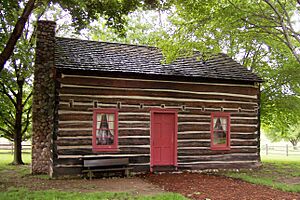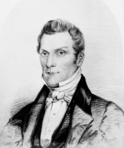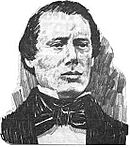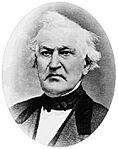Church of Christ (Latter Day Saints) facts for kids

The Church of Christ was the first name for the Latter Day Saint church started by Joseph Smith. It began informally in 1829 in upstate New York. Then, it was formally organized on April 6, 1830. This church was the first group to follow the ideas in Smith's new book, the Book of Mormon. Its creation marked the official start of the Latter Day Saint movement.
Over time, the church used other names. These included the Church of the Latter Day Saints (starting in 1834), the Church of Jesus Christ, and the Church of Jesus Christ of Latter Day Saints (by 1838).
Joseph Smith and his followers believed the Church of Christ was a restoration of the early Christian church. They thought the original church had lost its way. After Smith passed away in 1844, there was a disagreement over who should lead. Most members followed Brigham Young to the Salt Lake Valley. Other smaller groups stayed in Illinois or moved to Missouri. Many of these groups still exist today. Each one believes it is the true continuation of Smith's original "Church of Christ."
This church is different from other groups with similar names. For example, it is not related to the United Church of Christ or the Churches of Christ. Today, there are still several Latter Day Saint groups called "Church of Christ."
Contents
How the Church Started (Before 1830)
The idea of a "church of Christ" first appeared in the Book of Mormon. Joseph Smith dictated this book between April and June 1829. As he dictated, the idea of a group of believers with a church structure became clear. This structure would have God's authority. It would also include practices like baptism and leaders.
In April 1829, Smith dictated a story about Alma the Elder. Alma was a former priest who baptized his followers. He called his group the "church of God, or the church of Christ." The book said Alma's church leaders were priests. They did not get paid and taught about "repentance and faith in the Lord." Alma later started many congregations. They were all seen as "one church" because they taught the same things. The church leaders also included teachers.
In May 1829, Smith said he received a revelation. It described the church in simple terms. It said, "whoever repents and comes to me, the same is my church." The Book of Mormon also mentioned there were only "two churches." One was "the church of the Lamb of God," and the other was "the church of the devil."
Also in May 1829, Smith and Oliver Cowdery said John the Baptist visited them. He gave them the Aaronic priesthood. This gave them the power to baptize people in Jesus Christ's name. Smith and Cowdery then baptized each other. They also baptized many other people starting in June 1829. These new members were not part of a formal church yet. However, they called themselves "the Church of Christ." They lived in three New York towns: Fayette, Manchester, and Colesville.
In June 1829, Smith dictated another revelation. It said that the Book of Mormon contained "all things written, concerning my church." It also said that if they built up the church, "the gates of hell shall not prevail against you." Later in 1829, Oliver Cowdery said he received a revelation. It was about how to build the church. This revelation was called the "Articles of the Church of Christ." It said the church should ordain priests and teachers. The church was to meet regularly to share bread and wine. Cowdery was called "an Apostle of Jesus Christ." By April 1830, this informal "Church of Christ" had about six elders and 70 members.
Organizing the Church
On April 6, 1830, Joseph Smith, Oliver Cowdery, and about 30 believers met. Their goal was to officially organize the Church of Christ as a legal group. It is not completely clear where this meeting happened. Some say it was at the home of Peter Whitmer Sr. in Fayette, New York. Others say it was at the log home of Joseph Smith Sr. near their property in Manchester, New York.
Soon after this official organization, small groups called branches were set up. These were in Manchester, Fayette, and Colesville. The goal was to make the church a legal organization. However, it seems they did not follow all the legal steps needed at the time. No official records of incorporation have been found.
Where the Church Was Organized
Before 1834, all church writings said the church was organized in the Smith log home in Manchester, New York. This home was on the Samuel Jennings property in Palmyra. The Smiths might have built a second log home on their own land.
Starting in 1834, some church writings began to say the meeting was in Fayette. They said it was at the home of Peter Whitmer Sr.. The Whitmer home was a place where many other church meetings happened around that time. After 1834, some official church accounts still said the meeting was in Manchester. Several people who were there also said it happened in Manchester.
Some researchers believe the organization happened in Manchester. They think the confusion came from people remembering different meetings years later. Some critics suggest the location was changed on purpose in 1834. This was around the same time the church's name changed. They think it was to make the new church seem different from the "Church of Christ." This might have been a way to avoid paying debts.
However, there is also evidence for Fayette as the location. For example, an early version of a church book said a revelation was given in Fayette on April 6, 1830. This was after the church was organized. But when the book was published in 1833, it said "Manchester."
Today, the largest Latter Day Saint church, The Church of Jesus Christ of Latter-day Saints (LDS Church), accepts Fayette as the official location. Joseph Smith's own history, started in 1838, also listed Fayette as the founding place. In 1887, David Whitmer, who was there, said the event happened at his father's home in Fayette. But years earlier, in 1875, Whitmer had told a reporter it happened in Manchester.
What Happened at the Organization
Later accounts describe the April 6 meeting as a very spiritual event. Members had visions, prophesied, spoke in tongues, shouted praises, and even fainted. At this meeting, the church officially set up its leaders. These leaders held priesthood offices like deacon, teacher, priest, and elder.
According to their 1831 account, Smith and Cowdery were each ordained as "an apostle of Jesus Christ, an elder of the church." This account was changed in 1835. It then said Smith was ordained the "First Elder," and Oliver Cowdery was the "Second Elder."
First Members of the Church
According to the LDS Church, the first six members of the Church of Christ were:
- Oliver Cowdery
- Joseph Smith
- Hyrum Smith
- Peter Whitmer Jr.
- Samuel H. Smith
- David Whitmer
Other early members included the Three Witnesses and the Eight Witnesses to the Book of Mormon. Members of the larger Whitmer and Smith families also joined. Friends and acquaintances, like Porter Rockwell, were also early members.
The Church's Name
Why the Name Changed
Joseph Smith's revelations told the church to organize as the "Church of Christ" in 1830. In several revelations, God referred to the church by that name. Smith taught that this church was a return to the first Christian church. He also taught that this return happened in the "Latter Days." This meant the time just before the Second Coming of Jesus.
Early Name Changes
Many other churches in the Restoration Movement were also called "Church of Christ." This caused some confusion for Smith's followers. Because Smith's followers believed in the Book of Mormon, people outside the church started calling them "Mormonites" or "Mormons." Smith and other church leaders thought the name "Mormon" was insulting.
In May 1834, the church decided to change its name. It would then be known as "The Church of the Latter Day Saints." At different times, the church was also called "The Church of Jesus Christ," "The Church of God," and "The Church of Christ of Latter Day Saints."
In the late 1830s, Smith and his loyal followers moved to a new headquarters in Far West, Missouri. In Far West in 1838, Smith announced a revelation. It renamed the organization the "Church of Jesus Christ of Latter Day Saints."
Later Name Variations
Until Smith passed away, the church was known as the "Church of Jesus Christ of Latter Day Saints." Sometimes it had a hyphen, sometimes not. After Smith's death, different Latter Day Saint groups formed. They were led by various successors.
The largest of these groups, led by Brigham Young, is now based in Salt Lake City, Utah. It continued to use "Church of Jesus Christ of Latter Day Saints." In 1851, when it became a legal organization, it standardized its name. It became "The Church of Jesus Christ of Latter-day Saints" (LDS Church). Followers of James J. Strang use the name "Church of Jesus Christ of Latter Day Saints."
The name "Church of Jesus Christ of Latter Day Saints" was also used by members who saw Smith's son, Joseph Smith III, as his father's successor. Joseph Smith III became the leader of this group on April 6, 1860. However, in 1872, this church became a legal organization as the "Reorganized Church of Jesus Christ of Latter Day Saints" (RLDS Church). This was to tell it apart from the larger Utah church. In 2001, the RLDS Church changed its name again to "Community of Christ." This name was chosen to remind people of the original "Church of Christ" name.
The group led by Sidney Rigdon became smaller. Then, one of its leaders, William Bickerton, reorganized it in 1862. It was called "The Church of Jesus Christ." Other Latter Day Saint groups went back to the original name or a similar one. These include the Church of Christ (Temple Lot) and the Church of Jesus Christ (Cutlerite).
Who Claims to Be the Original Church?
Almost every Latter Day Saint group claims to be the true continuation of the original Church of Christ. They all see Joseph Smith as their founding prophet or first president. For example, the LDS Church, Community of Christ, and Church of Christ (Temple Lot) all say they were organized by Smith on April 6, 1830. This was the date the Church of Christ was officially formed. Other groups, like The Church of Jesus Christ (Bickertonite), admit they formed later. But they still claim to be a re-establishment of the original church.
In an 1880 lawsuit, an Ohio court said the RLDS Church was the rightful successor to Smith's original Church of Christ. The court also said the LDS Church was not the rightful successor. This was because it had "departed from the faith, doctrines, law, ordinances and usages of the said original Church." These were early findings, and the case was later dismissed.
In 1894, a federal United States court in Missouri again said the RLDS Church was the rightful successor. However, on appeal, the entire case was dismissed. The higher court did not discuss who was the legal successor.
See also
- History of the Latter Day Saint movement
- List of denominations in the Latter Day Saint movement






